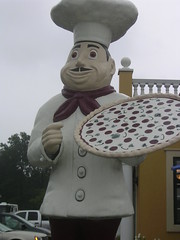322 Wilson Boulevard
Arlington, VA
The suburbs of northern Virginia exude a particular terror: clean and new, built for people who don't want to live in a place previously inhabited by other people. The immense condominium complexes that stretch for block upon block in centers of “urban village” development around Alexandria, Arlington, and Tysons Corner turn their glass faces to the highway proclaiming transparency – walls of windows, the light of truth, a world without history, and a "Corner Bakery Cafe" on the ground floor.
 |
| Crystal City skyline. By Kevin Bowman |
Do they qualify as “edge cities”? They balance on the knife blade separating the visible universe from a dark covert universe of lies. When confronted with this phalanx of architectural obliteration one feels the dropping-away of solid earth. No less than the man-made islands of Abu Dhabi, this built environment is pure liquidity temporarily stored in concrete and steel. Listen closely and you can hear the flow of capital cascading into a bottomless void that opens up underneath the Pentagon City Metro station. These sites are worse than haunted. With signals scrambled and the map wiped clean, the dead have nowhere to rest; they and their secrets are caught in that planner's darling, the traffic-calming urban roundabout.
The whispers and spectral visions that visit me in the suburbs of northern Virginia are not, however, incompatible with eating pizza. Pizza is a cornerstone of Cold War American empire and as such belongs in NoVA as much as transplanted Iranian real estate moguls and Salvadorian refugee day-laborers. There's a pizza place called Shakey's that people who grew up around here remember fondly, but it's gone now, but at least they can remember something. Other pizza joints in this mold live on. They are frozen in a moment of 1960s suburban exuberance about pizza: we take bread, add a mealy tomato broth spiked with oregano, and overlay a slab of mozzarella white, flat, and thick as the grave markers at the nearby National Cemetery.
Today's pizza palace of yesterday is Mario's in Arlington. Mario's is located on Wilson Boulevard – Wilson Boulevard, for our 28th president, a man who believed that foreign policy must spread democracy using a variety of means. On the other side of Wilson Boulevard is a thicket of condos. A Pizza Club observer describes “[an] unsuspenseful Rear Window… revealing frat boys playing beer pong and large flat screen TVs illuminating darkened rooms.” Transparency is meaningless, under the surface there's just beer pong in a condo lounge on a Saturday night.
Mario's models the mid-century roadside dairy shack vernacular, low-slung building, towering swoopy light-box signage. Carvel ice cream novelties come from a front window, pizza comes from a counter inside where different people will talk to you and shout your order at each other until someone makes you a pizza. Pies emerge onto outdoor picnic tables over which darkened human forms hover. In the Arlington twilight, mozzarella catches the neon glow.
The pizza is a rectangle, rolled out with a rolling pin. Many compared it to “French bread” pizza products found in the frozen food aisle. Locals explained to us that Mario's pre-bakes, tops, and then bakes again for speedy order fulfillment. The crust is thick, bready, and chewy; it begins to dry out after the ten-minute mark. There's not much sauce to help you deal with this, only cheese, so much cheese. And toppings if you get them. They're under the cheese. It's not fake, it's just the inoffensive American idea of mozzarella still often spotted in elementary school lunches. The term “cheeze-lastic” was proposed as a descriptor. It recreates the flavor landscape of its time -- a flat line rather than peaks and valleys. Cookbooks were casserole-based, acceptable spices were salt, pepper, and oregano.
Mario's has been in this place for fifty years circa 2007 when they put up a sign to that effect. Why in the throes of a deep and abiding unease did we gravitate towards its lights? Among the history-swallowing anti-monuments of NoVA Mario's stands as a witness to precisely those decades when America's relationship with the past imploded in a mushroom cloud of denial, anger, and ignorance both willful and imposed. How fucked up was it? The quaint hamlet of Arlington was home to an “American Nazi Party" which picketed the local pizza parlor for serving African Americans and Jews; the year was 1961. Mario's, along with the rest of the town, reckoned with these bizarre hate-mongers in their midst until the 1980s. You can still eat essentially the same pizza that sort of stood up for Civil Rights because the pizza survived while the hate group bit the dust.
Further reminisces confirm the Mario's pie as a historic survival. “This is old-school pizza you're not old enough to have a memory of,” a Pizza Club gen-Xer admonished the scribe. “It feels like I'm on a beach vacation when I was ten years old,” another remarked. “I grew up on this stuff,” our local informant added, instructing us in the proper microwave revival technique. You might be tempted to reheat this pizza in a toaster oven, but only microwave radiation should be used for period accuracy.
Mario's rescued Pizza Club from a serious paranoia trip. We want to touch the good and evil of the past, we want to feel something (cheese) in the pit of our stomachs. By all means build the progressive dense “urban suburb” of the future and build it here where it can help the maximum number of people commute to work in defense contracting. But know that the sleek visibility is false and the transparency is an illusion – you'll only glimpse the truth in the distorted gleam off an expanse of Mario's mozzarella.
5/8 slices
Pizza photo credits: Katy





No comments:
Post a Comment